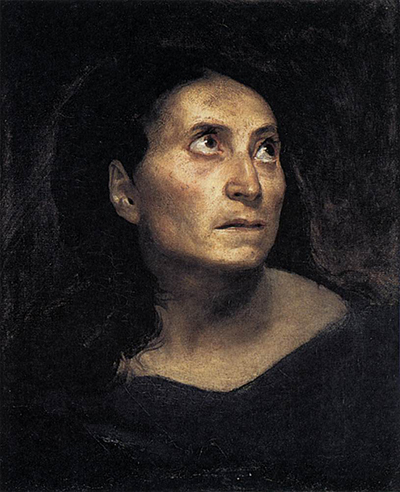This artwork was completed between 1823-1824, with different sources conflicting over which of these years it was. Some have also stated the use of graphite, whilst others describe it as an oil on canvas.
Something we are sure of, though, is that this was a study piece for his later masterpiece, The Massacre at Chios. One can see this woman appearing in that painting in the bottom right of the foreground, with a fairly identical facial expression. One can derive from that, therefore, that Delacroix was satisfied with his work with this study and so chose not to make any great amends to her when completing the larger artwork. Interestingly, though, she is a full figure portrait within that artwork, where as here we see a shoulder-length portrait, suggesting that Delacroix was only interested in practicing her facial expressions and was happy to leave the other elements of her body to consider at a later date. The lighting here is dramatic, with darkness all around except upon the woman's face. This technique is known as chiaroscuro. This piece is also sometimes known as Head of an Old Greek Woman, such as by the Metropolitan Museum of Art who loaned the painting recently for a major Delacroix exhibition.
The loan was made by the permanent owner's of the artwork, namely the Fine Arts museum of Orléans, France. They own over 2,000 paintings so would have been able to accomodate this short term loan and simply made use of some of their other artworks that were not previously on display at the time. Despite being a lesser known provincial museum, they still boast some major names within their collection, including the likes of Correggio, Annibale Carracci, Antoine Watteau, François Boucher, Hubert Robert and Gustave Courbet as well as a large number of sculptures too, including pieces by Baccio Bandinelli and Auguste Rodin. They also stage their own exhibitions from time to time, which maybe easier to organise having generously loaned out items from time to time.
Portraiture was not one of Delacroix's main genres, but in this case it was entirely necessary to practice and experiment with various parts of the later painting in order to have a clear understanding of it before he started. There were most likely a number of other study drawings and paintings in preparation for this major artwork, as this woman was just one of a number of prominent figures within the overall composition. These types of paintings help us to learn much more about the working processes of Delacroix, which we can then compare to other artists of the same period to find unique elements to their respective careers.




